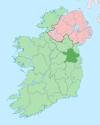Rathmolyon
Rathmolyon
Ráth Moliain | |
|---|---|
Village | |
 St. Michael's and All Angels Church, Rathmolyon | |
 Rathmolyon Location in Ireland | |
| Coordinates: 53°29′20.4″N 6°44′40.2″W / 53.489000°N 6.744500°WCoordinates: 53°29′20.4″N 6°44′40.2″W / 53.489000°N 6.744500°W | |
| Country | Ireland |
| Province | Leinster |
| County | County Meath |
| Elevation | 76 m (249 ft) |
| Population (2016)[1] | 334 |
| Time zone | UTC+0 (WET) |
| • Summer (DST) | UTC-1 (IST (WEST)) |
| Irish Grid Reference | N833483 |
Rathmolyon (/ræθmɒˈlaɪn/; Irish: Ráth Máigh Laighin, meaning 'ringfort of the Leinster Plain') is a village in the southern portion of County Meath, Ireland, situated 8 km south of Trim. It is situated at the junction of the R156 regional road and the R159 regional road connecting Trim to Enfield. Rathmolyon serves as a service center for the surrounding rural area.
Public transport[]
Bus Éireann route 115A provides a commuter link from Rathmolyon to Dublin via Summerhill and Dunboyne with one journey in the morning and an evening journey back every day except Sunday.[2]
Local history[]
The village developed at the junction of two regional roads. A number of buildings in the village date from the Georgian and Victorian periods. During the late 19th century, the area played a role in the development of the Two by Twos and Cooneyite movement,[3] the only religion known to have had its origin in Ireland.[4]
Notable or historic buildings in Rathmolyon include a Catholic church, a Protestant church, two public houses, Cherryvalley House, Rathmoylon Villa and Rathmoylon House.[5]
Development[]
The population of Rathmolyon almost doubled in the ten years between the 2006 census (168 inhabitants) and the 2016 census (334 people).[1][6] According to the 2016 census report, almost 50% of the town's houses (53 of 108 households) were constructed between 2001 and 2010.[1]
The "Rathmolyon Esker" east of Rathmolyon has been proposed as a Natural Heritage Area.[citation needed]
See also[]
- List of towns and villages in Ireland
References[]
- ^ Jump up to: a b c "Sapmap Area - Settlements - Rathmolyon". Census 2016. Central Statistics Office. April 2016. Retrieved 17 February 2020.
- ^ http://www.buseireann.ie/inner.php?id=247#Meath[bare URL]
- ^ Dair Rioga Local History Group, Mallon and Greaney editors. 2005. All in Good Faith: A History of Christianity in Enfield, Rathmolyon, Rathcore and Associated Areas. Ireland: Dair Rioga Local History Group and the Meath Leader under the NRDP Programme of the Department of Community, Rural and Gaeltacht Affairs / National Development Plan.
- ^ Robinson, James. 2005. Pentecostal Origins: Early Pentecostalism in Ireland in the Context of the British Isles: Studies in Evangelical History and Thought. Milton Keynes, United Kingdom: Paternoster, p. 34. ISBN 978-1-84227-329-6
- ^ "Rathmolyon Draft Local Area Plan" (PDF). Meath County Council. 2008. Archived from the original (PDF) on 15 February 2012.
- ^ "Rathmolyon (Ireland) Census Town". citypopulation.de. Retrieved 17 February 2020.
- Towns and villages in County Meath

